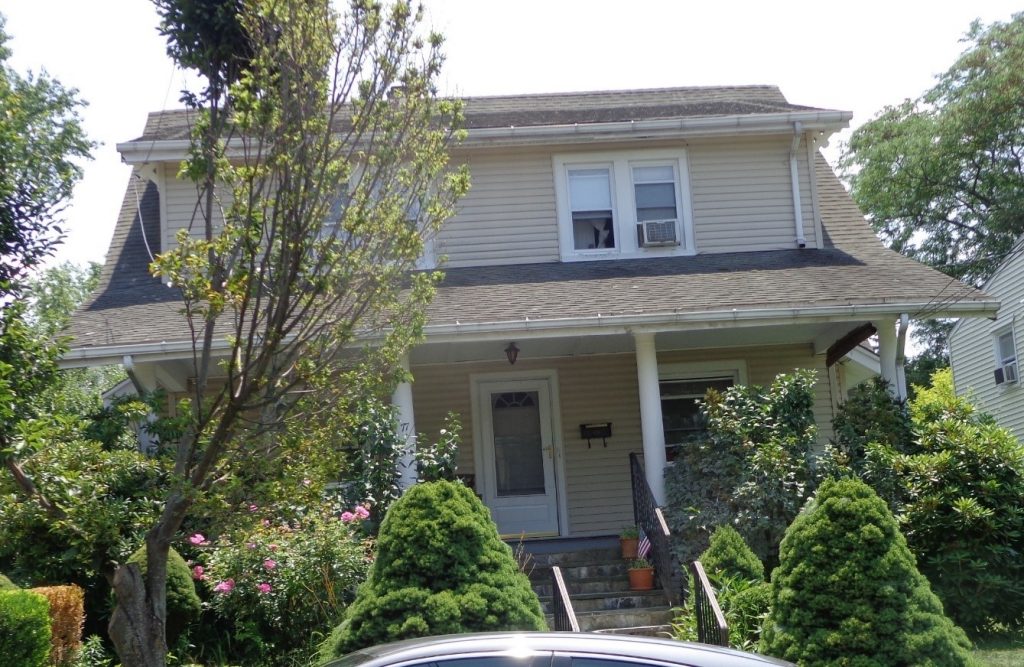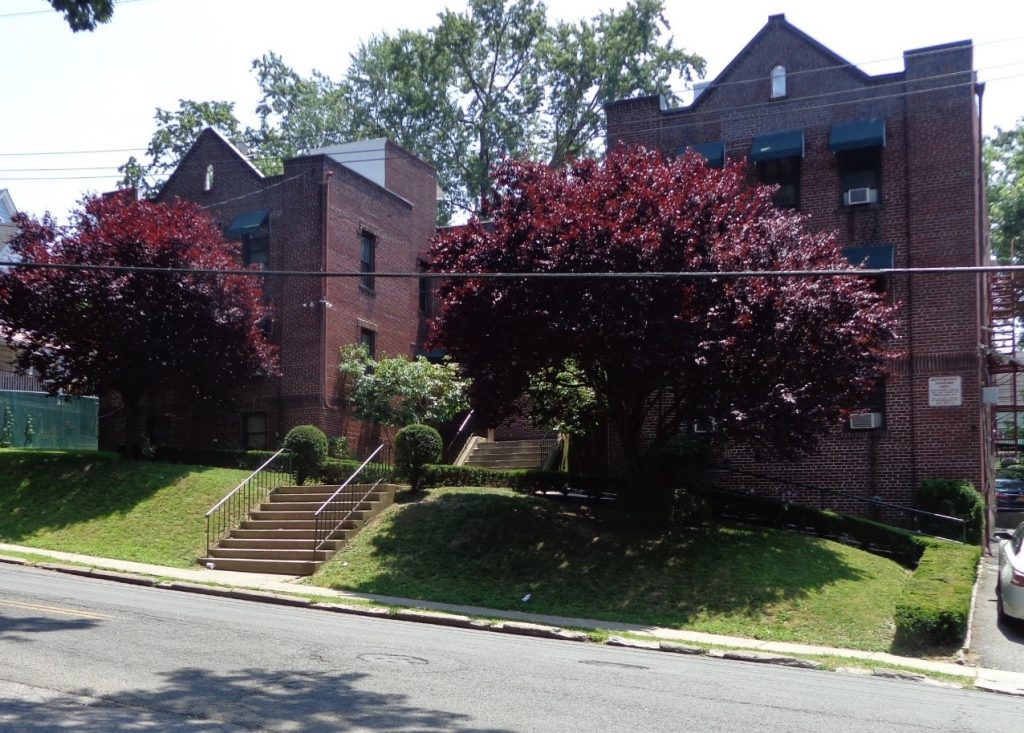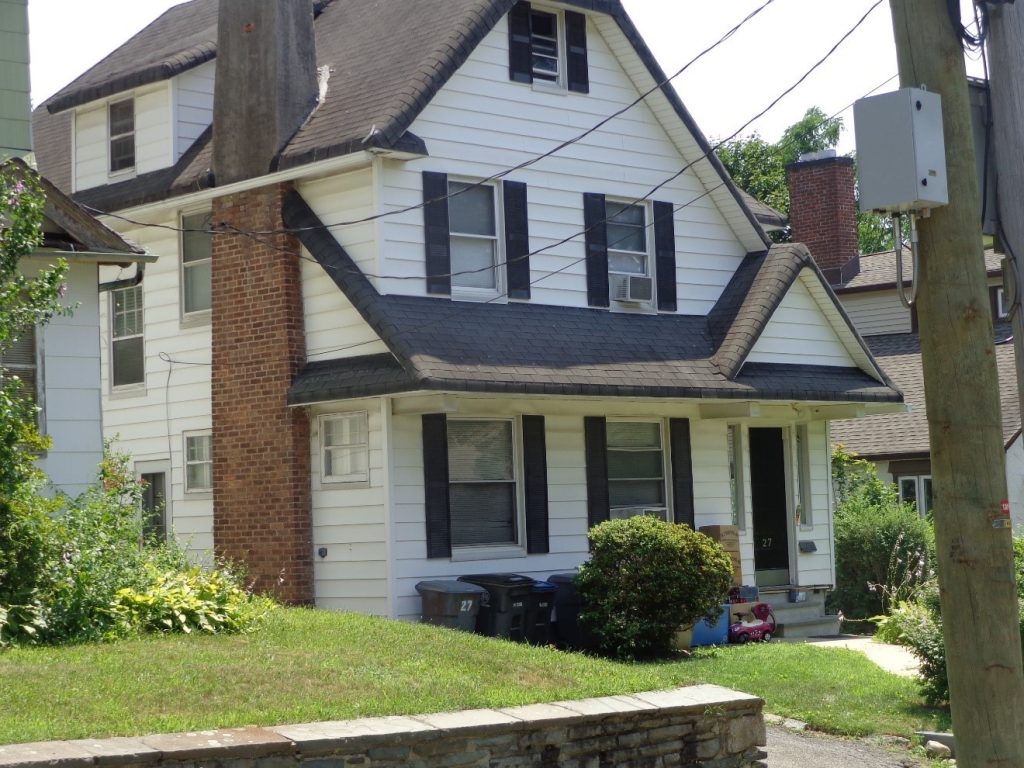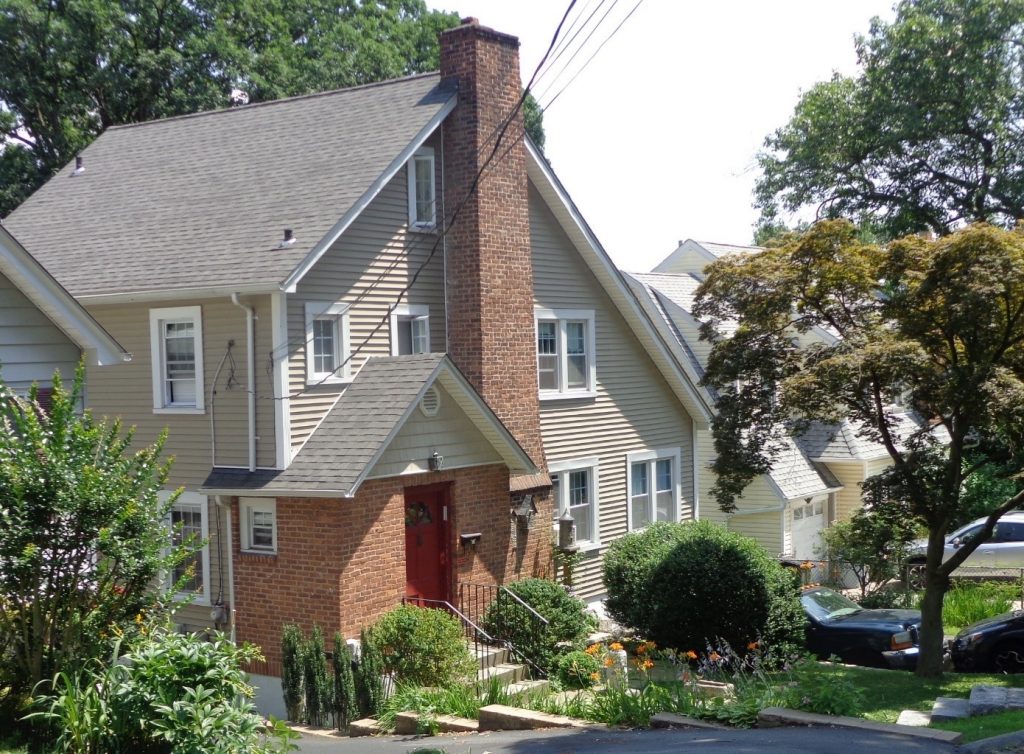The Great Depression began in 1929 and continued until the national effort a few years before entering the Second World War in1941, after the bombing of the American Naval Base at Pearl Harbor. Relative to the times, White Plains was a rather urbanized city with a robust downtown area for shopping and business, a grand county court house, and its position of being the County Seat of Westchester County, New York. On north, south, east and west sides of the downtown area, were apartment houses, tenements and many single-family homes. It was by any standard a very walkable town. During the Great Depression it was not uncommon to see “for sale” and “for rent” signs on many houses. People could not afford to buy houses and banks were reticent to provide mortgages. A house could be purchased for several thousand dollars, which was all the money in the world for most families.
Canio and Angie Nannariello moved often into nice houses that were for rent in favorable neighborhoods. The circumstances of why they moved included finding a cheaper place or possibly the house they were renting was sold. One house was rented with good friends, Lucy and Jimmy Gentile; Lucy becoming the Godmother of Richard Nannariello. Another house, had an extra room for Grace Nannariello, Charlie’s sister, and her daughter Lucy. Another house, which was a one family house, had the second floor jointly rented with friends. It was the Great Depression and the operative and guiding motive was “survival.”
Interestingly, as this Ancestry is being published all but one of these homes is still in existence and is inhabited. Therefore, many homes are in the range of being about one hundred years old, more or less. Most of these houses look better now than they did when originally built or recalled back in the 1930’s and 1940’s. To use an old builder’s term, many of these homes have “very good bones,” which accounts for their survival. Except for the apartment house on Battle Hill Avenue, all of the houses had front porches. It was the day of living in the front of your home and enjoying cool breezy afternoons and nights in the hot summer weather. Air condition was nonexistent. All of the photos of these homes were taken in 2018.
There is no documentation or oral history available regarding the houses the Nannariello’s lived in starting in 1927 when they were married and until 1933. Charlie and Angie finally bought their first home around 1943 at 1 Fairfield Street in White Plains for approximately $3,500. That was a very hearty sum of money at the time. In writing this Ancestry, there was a need to sometimes deduce the dates when certain events occurred. A recollection of the house the Nannariello’s lived could be associated with the school their children attended and the grade in school. Notes and comments on each of these houses is a way to trace some of the biographical information about Charlie and Angie. Canio began his life in his first home in Calitri, Italy; and Angie began her life in her first home in Brewster Heights, Putnam County, New York.
They both lived in their last home at 36 Greenridge Avenue in White Plains, New York. This home was only a few blocks away from White Plains Hospital where their two sons where born. Every home they lived in after arriving in White Plains, continued to be in White Plains. The review of some of the homes they lived in provides some insights into their journey. It was a wonderful journey!
History of White Plains New York
Westchester County and White Plains for many Nannariello’s and many Passarella’s was the center of their universe. As described in other topics in this Ancestry, some of the Nannariello did live in New Rochelle and other cities towns and cities in Westchester County. On the Passarella side of the family, all six of the Passarella children lived in White Plains for many years and raised their children. Their children often worked and married and lived in White Plains or possibly adjacent towns.
As of 2020, White Plains is a city of about 60,000 people. It is the County Seat of Westchester County, a densely populated county of about one million people. The daytime population in White Plains is estimated to be about 250,000 people because of the business and shopping infrastructure. It is 25 miles north of downtown Manhattan. The New York Central Railroad Harlem Division delivers thousands of White Plains commuters each day to New York City. White Plains has long been a commuter town both sending and receiving commuters each day. Over recent years, probably as many commuters are coming to White Plains each day as are leaving.

White Plains was part of the Town of Rye until 1788 when the town of White Plains was created. It became the County Seat in 1758 when the colonial government for Westchester, then called West Chester, departed from The Bronx in New York City to be closer to where the citizens lived.
On July 9, 1776 the Declaration of Independence was delivered to the White Plains Court House from Philadelphia. The Declaration was adopted, independence declared, and the State of New York was formed. The Declaration was read from the White Plains Courthouse on July 11, 1776. The courthouse was located where the current Armory is located on Broadway.
George Washington occupied what is now called Battle Hill in White Plains in October 1776. Washington eventually retreated from a superior force directed by General William Howe. Washington stayed at a building that still stands called the Miller House in the northern part of White Plains, After several skirmishes, Washington and his troops retreated after having stopped General Howe offense. Howe departed White Plains on November 5, 1776 after parts of the town were burned by the British Troops.
After the Second World War, there was a boom in building and shopping. Macy’s built a large store on Main Street and this was a keystone event in 1949. Through the 1960’s and 1990’s, many Expressways and parkways connected White Plains in all directions to the evolving structure of the Interstate Highway system. This required many parts of White Plains to be rebuilt and rerouted. The urban renewal project that started in 1960 resulted in a complete demolition and rebuilding of the downtown area, one of the earliest and largest Urban renewals in the United States.




77 Trenton Avenue, White Plains, New York

The house at 77 Trenton Avenue in White Plains, NY was a two-family house the Nannariello’s rented and shared with Rose and Joe Ferrer. Rose and Angie’s are sisters. Charlie and Angie’s son Richard Nannariello was born March 20, 1933, in White Plains Hospital, while they lived in this house. It was the midst of the Great Depression, and most Americans did not realize it would last for many more years and many rented and shared homes to survive.
All of the homes that Charlie and Angie lived in prior to this house are not known. They married in 1927 and likely lived in several rental apartments and homes in White Plains prior to this location. This house is in the Battle Hill section of White Plains. They lived in two other homes on the Battle Hill section of town over the years. Battle Hill was an American Revolutionary War sight once defended by George Washington, Alexander Hamilton and Count Rochambeau.
106 Battle Avenue, White Plains, New York

The Nannariello’s lived in the apartment wing on the left around 1937. The highest point in White Plains is Battle Hill, a relatively low but dominant mountain that overlooks White Plains. During the American Revolution, George Washington and the Count de Rochambeau used the hill as a lookout against the British. Alexander Hamilton, of “Hamilton” Broadway musical fame, was a very young aide to Washington and likely was in this part of White Plains. Battle Hill is a street that traverses the hill from east to west. Also, Battle Hill is a section of town and people will refer to their living on “Battle Hill” though they live on various streets in that section.
The crest of Battle Hill is a school that is a long two story all brick building that began as a Kindergarten to 8th grade school. Over many decades the school transitioned into the first location for Westchester Community College after World War II; and now is a very attractive re-purposed condominium complex.
The Nannariello children, Louis and Richard, attended Battle Hill School multiple times as the family moved in the following years and they had to change schools.
Brady Place, White Plains, New York
The Nannariello’s lived in a house on Brady Place in White Plains, NY. Brady Place was a dead-end street on West Post Road with possibly three houses on the east side and two or three on west side. . Sometime around 2017, Brady Place and the area around it was demolished and cleared for a future urban development. The street and houses no longer exist and therefore photos are not available.
A photo found later and not presented here, depicts Angie Nannariello and her son Louis, standing outside and showing the house on Brady Place in the background. It was occupied by Charlie and Angie Nannariello after moving from the Battle Hill apartment. A few friends of the Nannariello’s occupied nearby houses and obviously provided a very comfortable social situation.
No Photo is Available
1 Brady Place, White Plains, New York. The house has been destroyed.
27 Nutgrove Street, White Plains, New York

This house is at 27 Nutgrove Street in White Plains, NY. The Nannariello’s lived in it for a few years during the late 1930’s. The Nannariello’s lived on the first floor and shared rent with a younger couple who were good friends and lived on the second floor. Their son Richard attended his first school in Kindergarten at Rochambeau Elementary School on Fisher Avenue while living there. These were the days when children walked to school, returned home for lunch and then returned to school. There were limited school buses and the world was rather safe and uncomplicated.
1 Lester Place, White Plains, New York

This house at 1 Lester Place is in the Battle Hill section of White Plains. Lester Place intersects with Chatterton Parkway which runs to downtown White Plains and Main Street by the Train Station. They rented and lived in this house for a few years in the early 1940’s. During this time Charlie’s sister Grace Trotta and her daughter Lucy boarded with them. For a period of time Frank Passarella, Angie’s brother, lived with them in this house. Also, a boarder that Charlie took home because she was homeless lived with them. Mary Beth became part of the family in later years when she married Charlie’s nephew, Louis Nannariello.
1 Fairfield Street, White Plains, New York

Charlie and Angie moved many times before they were able to buy their first house. Finally, around 1944, they bought their first house at 1 Fairfield Street. This street intersected half way up the Orawaupum Street hill. Charlie took much pride in the house and projects to improve the house literally never ended. In the first year, Charlie planted a hedge along the entire front of the property. During a recent visit to the house, over 75 years later, that hedge still grows. Charlie meticulously used a hand hedge cutter to trim the hedge and it was a long time before his sons were allowed to cut the hedge. It was a ritual for Charlie to sweep the sidewalk and sweep the street in front of the house. When he was in his eighties, he continued the ritual of sweeping the sidewalk and the street in front of his house at South Lexington Avenue in White Plains, NY. This ritual of sweeping the street in front of your house was a carryover of the tradition in Calitri, Italy of living on pedestrian streets and everyone swept and washed their part of the pedestrian street daily.
There was a young lady, Ruth Brennan, who was a nurse at White Plains Hospital and became a boarder at the home. Ruth Brennan married Charlie’s nephew, Stanley Fusco, son of Mary and Morris Fusco.
After World War II was over in 1945, there was a huge demand for housing and very little housing available. The third floor of the house was an attic, and it was renovated as an apartment and was rented by their nephew, Joe Fusco and his wife Geri. Their first child, Joseph, was born while they lived there.
It was in this home, that Charlie eventually built a bar with tables and chairs in the basement. The bar would be generously stocked with various wines and liquors and he would love to entertain family and friends. While living in this house, the Nannariello sons, Louis and Richard, completed their high school education; both served in the Army; both married, and brought grandchildren to the home.
Charlie had achieved one of the American dreams to own his own home. He could not be more proud.
365 South Lexington Avenue, White Plains, New York

The house at 365 South Lexington Avenue was the home at which Charlie finally retired. The area of White Plains on South Lexington Avenue and for many blocks around is called “The Highlands.” It is not known the exact boundaries of the Highlands, but anyone born and raised in White Plains in the 1920’s or 1930’s and beyond knows it as an area of fine homes. The homes are laid out on very straight and well-defined grids of streets, running both north and south and east and west, that are for the most part tree lined. Over the years many of the old trees have survived, many of been taken down, and new generations of trees have been planted. As with all homes, Angie maintained the home meticulously. During their many years living there, they once had a small fire that did significant smoke damage. The entire house had to be renovated on the inside. Charlie had a bar built in the basement and tables and chairs laid out around the area. He took great pride in entertaining the family and grandchildren.
Gobby Passarella, Angie’s brother, lived with them for several years. It would be interesting to observe Gobby watch Television and listen to the radio as he watched and bet on multiple sports events. Charlie was completely oblivious to any sports activities.
Charlie would broom sweep the front of the house, including the street, anytime he cut grass or worked on the lawn. The tradition was learned from the daily ritual in Calitri of home owners sweeping the cobble stoned pedestrian streets in front of their homes. Charlie always wondered why his neighbors did not sweep the street in front of their homes.
Many wonderful years were spent in this home as their grandchildren grew up and visited. Sunday dinners and visits from their sons and grandchildren were a tradition.
It was in this home, that Charlie began to deal with the early stages of Alzheimer’s. Driving a car and finding his way around town became a challenge and unsafe without Angie being in the car to direct him. Taking care of the house was an issue. Angie and her sons, Louis and Richard, arranged to sell the house and find a more accommodating living situation.
36 Greenridge Avenue, White Plains, New York

The condo on 36 Greenridge Avenue in White Plains, NY replaced the house on 365 South Lexington Avenue. The house was sold because it was too big and a challenge to maintain. The condo required no work on the outside and much less work in the inside. Now, Charlie was dealing with the advanced stages of Alzheimer’s. The change to a condo provided comfortable housing with the minimum of maintenance. Charlie left this condo the last time when he was admitted to the Alzheimer Ward in the Ruth Taylor Institute at Westchester County Grasslands Hospital. There was a weekly ritual of Angie and her sons visiting Charlie at the Institute. Charlie passed on September 11, 1988.
Angie loved living here and entertaining family and friends. She often walked to do light shopping on Mamaroneck Avenue, only two blocks away. Angie lived here until she passed in January 1996.